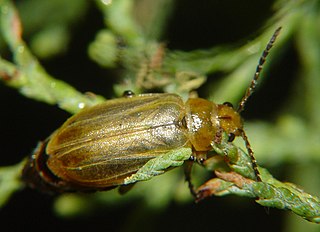
The elongated tortoise is a species of tortoise found in Southeast Asia and parts of the Indian Subcontinent, particularly Northeast India.

Ulmus elongataL. K. Fu & C. S. Ding , also known as the long raceme elm in the US, is a deciduous tree endemic to broadleaf forests in the eastern provinces of China.

The snaggletooth shark, or fossil shark, is a species of weasel shark in the family Hemigaleidae, and the only extant member of the genus Hemipristis. It is found in the Indo-West Pacific, including the Red Sea, from southeast Africa to the Philippines, north to China, and south to Australia, at depths from 1 to 130 metres. This shark can be found near the bottom of the water column of coastal areas, but can be found at continental and insular shelves. Its length is up to 240 cm (7.87 ft). Despite being only vulnerable to extinction, this shark is very rarely seen.
Hemipristis is a genus of weasel sharks, family Hemigaleidae. It contains one extant species, the snaggletooth shark and several extinct species.

The elongated shrew is a species of mammal in the family Soricidae. It is endemic to the island of Sulawesi in Indonesia. It lives in the forests of central, northern, and eastern Sulawesi from 200 to 2000 meters elevation.

Chiretolpis is a genus of moths in the family Erebidae.

Diorhabda elongata is a species of leaf beetle known as the Mediterranean tamarisk beetle (MTB) which feeds on tamarisk trees from Portugal and Algeria east to southern Russia. The MTB is used in North America as a biological pest control agent against saltcedar or tamarisk, an invasive species in arid and semi-arid ecosystems.
Chiretolpis atrifulva is a moth of the family Erebidae. It is found in New Guinea.

Chiretolpis bicolorata is a moth of the family Erebidae. It is found in Papua New Guinea.
Chiretolpis erubescens is a moth of the family Erebidae first described by George Hampson in 1891. It is found in India's Nilgiri Mountains.
Chiretolpis melanoxantha is a moth of the family Erebidae. It is found on the Moluccas.
Chiretolpis ochracea is a moth of the family Erebidae first described by Rothschild and Jordan in 1901. It is found in New Guinea.
Chiretolpis rhodia is a moth of the family Erebidae. It is found on the Maluku Islands.
Chiretolpis signata is a moth of the subfamily Arctiinae. It is found on the Louisiade Archipelago.
Chiretolpis sinapis is a moth of the family Erebidae. It is found in New Guinea.
Chiretolpis unicolor is a moth of the family Erebidae. It is found on Ambon Island.
Chiretolpis woodlarkiana is a moth of the family Erebidae.
Chiretolpis xanthomelas is a moth of the family Erebidae. It is found on the Tanimbar Islands.
The Nudariina are a subtribe of lichen moths in the family Erebidae. The taxon was described by Carl Julius Bernhard Börner in 1920.

Serruria elongata or long-stalk spiderhead is a plant belonging to the protea family. It is an erect, hairless shrublet of 1–1½ m (3½–5 ft) high with densely set, alternate, finely divided leaves lower down the plant, with needle-like segments. On top of an up to 30 cm (12 in) long inflorescence stalk are several, loosely arranged heads of pin-like, densely silvery-haired flower buds, each of which opens with four curled, magenta pink corolla lobes. The species is endemic to the southern Western Cape province of South Africa. It flowers during the southern hemisphere winter and early spring, between June and September.





